Jackery Explorer 500 Review: A Great All-Rounder Power Station

This Jackery Explorer 500 review has everything you need to know about this super-compact power station. I was lucky enough to get my hands on the Explorer 500 numerous times, which has helped my devices stay up and running on my outdoor trips. For the most part, it was able to do that without breaking a sweat.
Aside from that, since conventional recharging options are hard to come by when you’re in the middle of nowhere, I brought a solar panel to keep the Explorer 500 juiced up on my travels to the countryside. Read on to know how that panel fared and whether you’ll be better off with or without it.
*Disclosure: I only recommend products that I would use myself. This post may contain affiliate links that may earn me a small commission at no additional cost to you. Read the full advertising policy here.*
The Summary
The Jackery Explorer 500 has a super-rugged build, offers multiple charging options and lets you recharge it with a compatible solar panel. It also packs a 518Wh Lithium-ion battery and comes with a 24-month warranty. However, the absence of a USB-C port and the poorly thought-out design of the DC ports might put off some of its potential users.
Jackery Explorer 500 Review
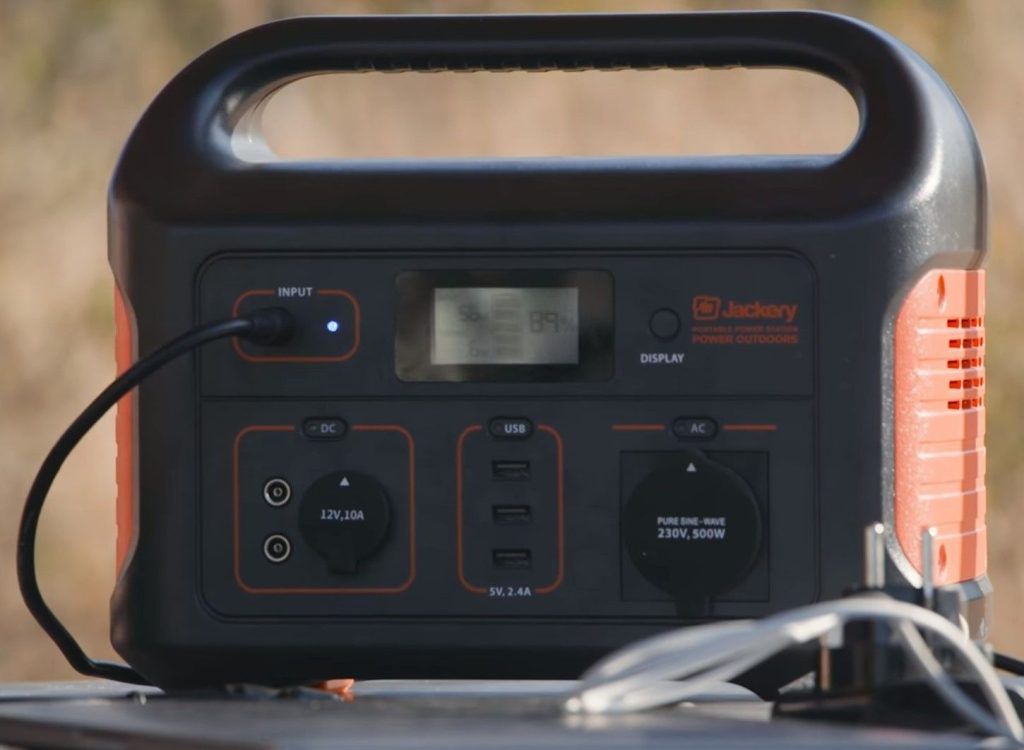
What’s In The Box?
- Jackery Explorer 500
- Car charging cable
- AC-to-USB converter (2 parts)
- User-Manual
Weight and Build
The Jackery Explorer 500 weighs just under 13.3 pounds. This makes it twice as heavy as the 6.6lbs weighing Explorer 240 and more than four times heavier than the Explorer 160. All of this is to say that the Explorer 500 isn’t incredibly easy to carry around.
Focusing on its build, a hard-plastic handle is molded into the rest of the body. Two air vents, one on each side, provide enough space for heat to dissipate. A 2-inch backlit digital display in the middle shows you the input/output wattage, remaining battery life and battery temperature.
Four rubber feet at the bottom help steady this portable power station on uneven surfaces. There’s another button on the sides pressing which you can turn on the SOS/emergency light. This is a nice feature, though one that is pretty common among power stations.
For products bought through Jackery.com, the company offers free shipping within the US, a 24-month warranty, free replacements and a 30-day money back guarantee.
Find out more here
Battery and Ports
The Jackery Explorer 500 packs a middle-size 518Wh, Li-ion battery. The battery is capable of retaining 80% capacity for the first 500 charging cycles. A Battery Management System (BMS) protects it from overcharging, over-current, and under-current.
I can say from experience that the BMS works. During one of my camping trips, I tried to plug in a CPAP machine of a fellow camper. As it turned out, the machine needed more power than the battery could supply. The BMS detected this and promptly turned off the Explorer 500.
As stated above, a backlit LCD screen adorns the control panel, with a small charging port on its right side, beneath which lay one carport and two DC ports. Next to them are three USB-A ports, before one AC outlet (100V/500W; 1000W peak) completes the lineup.
Unfortunately, the design of the DC ports is poorly thought out. Jackery says they are made for plugs with 6.5mm x 1.4mm dimensions. These are specs that aren’t easy to find (to put it mildly). I feel that Jackery could have easily avoided this issue by opting for a more common plug spec.

Recharging Options
You have four options to recharge the Explorer 500:
- AC wall outlet – 7.5 hours
- 12V car adapter – 7.5 hours
- Electric generator – 7.5 hours
- Compatible Solar Panel – 9.5 hours under full sunlight
Other Notable Features
Here are other stand-out features of the Explorer 500:
- Supports pass-through charging. Pass-through charging enables the 500 to recharge your devices while it’s being recharged itself. This means you won’t have to wait for this model to be juiced up before it could power up your devices.
- Has MPPT charge controller. Solar charging compatible power stations are available in two types: those with a built-in MPPT controller and those without. The first type, like the Explorer 500, can be charged much quickly with a compatible solar panel.
- Individual on/off buttons. All of this model’s outputs have their separate on/off switches. This is an exciting feature as it ensures that while you’re drawing power from one of the sources, the idle ones are turned off (and not consuming power).
- Pure sine-wave inverter. Pure sine wave inverters let you charge sensitive electronics without any risk of damage. That is something modified sine wave inverters, whose power supply is different from an actual sine wave, can’t do.
Pros and Cons
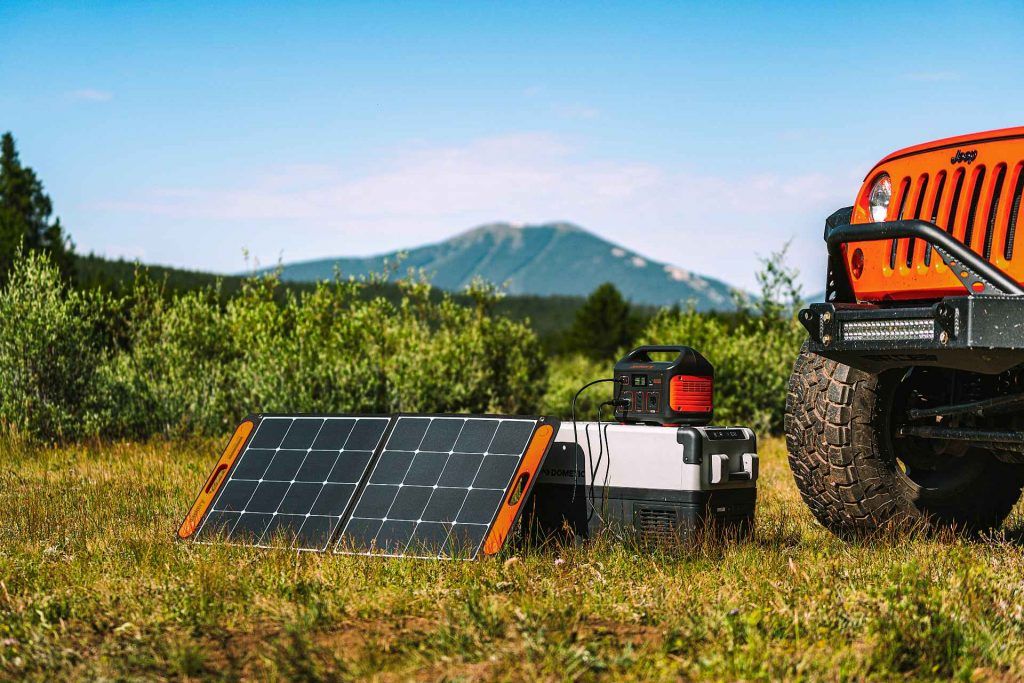
The Jackery Explorer 500 offers various useful features. They include support for pass-through charging, a built-in MPPT controller and sturdy, durable construction. However, as highlighted above, it also has its fair share of shortcomings. Let’s look at the pros and cons of Jackery Explorer 500.
Jackery Explorer 500 Pros
- Four charging options
- Built-in MPPT controller
- Supports pass-through charging
- Pure sine-wave inverter
Jackery Explorer 500 Cons
- No USB-C port
- Poorly thought-out design of the DC ports
Best Solar Panel for Jackery Explorer 500

The Jackery SolarSaga 100W is the best solar panel for Explorer 500. Jackery claims this solar panel can take the Explorer 500 from zero to a hundred percent within 9.5 hours. Having been able to test this solar panel a few times, I can tell you that Jackery is right on that count.
The SolarSaga 100W comes with top-of-the-line monocrystalline solar cells. Ones that boast a market-high conversion efficiency of up to 23%. It also has a laminated upper surface to prevent outdoor elements from disturbing the efficiency. The lamination also makes this solar panel quite easy to clean.
Connecting it to the Explorer 500 is pretty straightforward, too. All you have to do is take the included Anderson connector cable, plug it into an extension cable, and hook up the latter into your Explorer 500. The entire process won’t take more than 2 minutes if done correctly.
You can rely on the SolarSaga 100W to charge various other devices too. It comes with 2 USB ports to juice up your smartphones, tablets and other gadgets. That too while it’s powering up the Explorer 500. If you decide to buy it, get it registered with Jackery to get an extra year on warranty.
How It Compares With Other Portable Power Stations
Jackery Explorer 500 Vs Goal Zero Yeti 500X
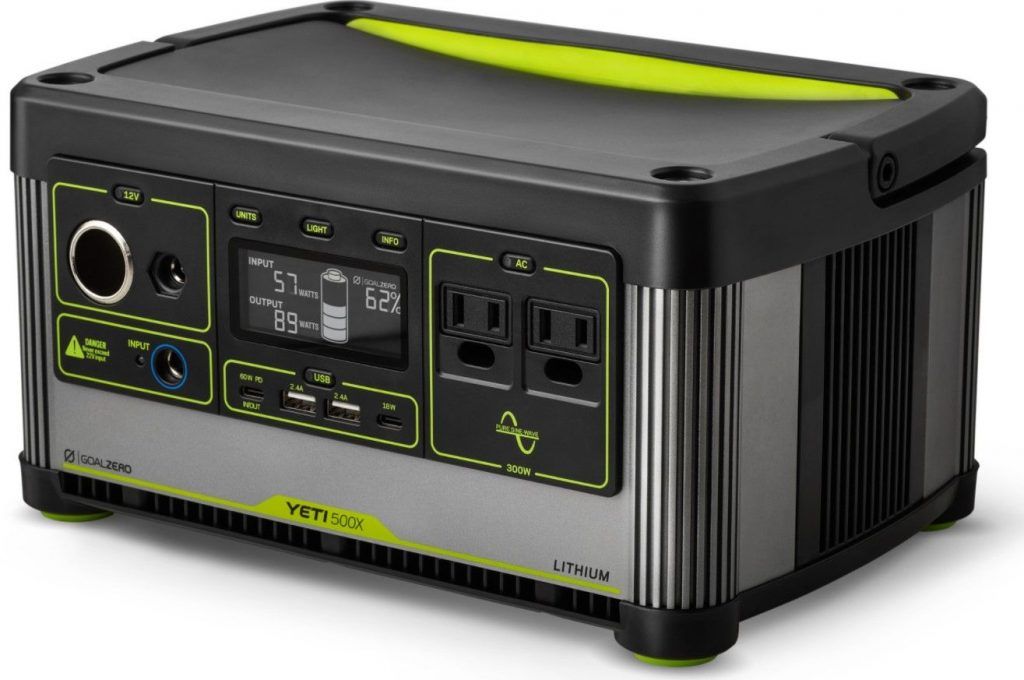
Goal Zero Yeti 500X
- Power: 505 Wh
- Weight: 12.9 lbs.
- Dimensions: 11.2″ x 7.5″ x 6″
- Ratings: 4.7⭐ out of 102 reviews on Amazon
- Similarities: Both the Jackery Explorer 500 and Goal Zero Yeti 500X have sine-wave inverters. They also possess a built-in MPPT controller and support pass-through charging. Both can be recharged with a compatible solar panel, have backlit LCD displays and are protected by BMS.
- Where the Explorer 500 fares better: The Explorer 500 packs a slightly bigger battery (518 Wh vs. 500Wh). It also offers one extra recharging option (electric generator), comes with more items in the box and lets you extend its solar panel’s warranty by one year (3-year vs 2-year).
- Where the Yeti 500X fares better: In contrast to the Explorer 500, the Yeti 500X comes with a USB-C port. It also gives you the option to daisy chain its solar panels, something which you can’t do with SolarSaga 100W. Plus, it offers a higher surge wattage (1200W vs. 1000W).
Jackery Explorer 500 Vs Rocksolar Nomad 400/600
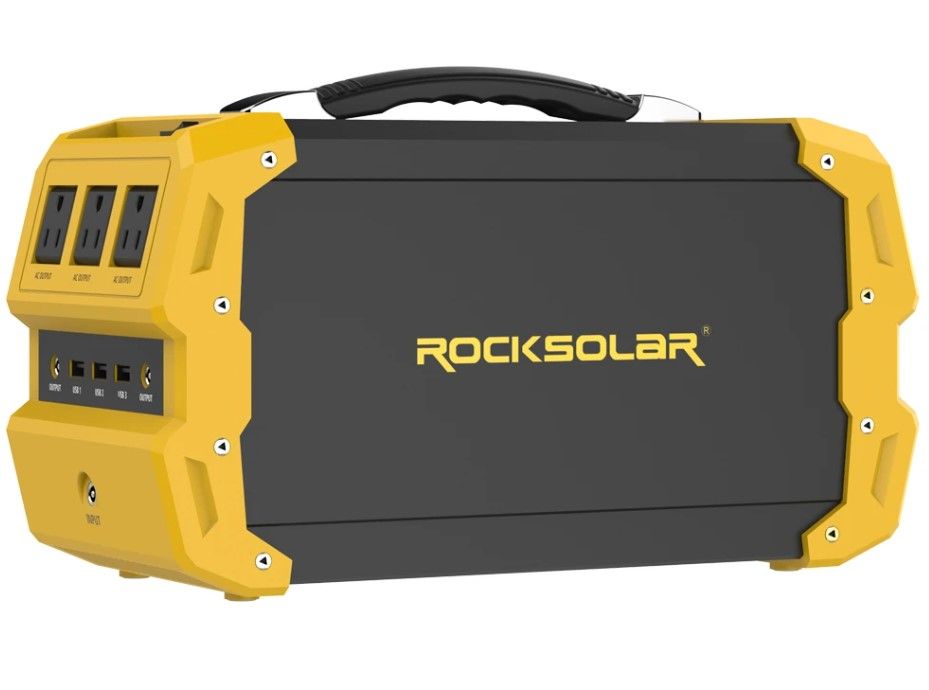
Rocksolar Nomad 400/600W
- Power: 444 Wh
- Weight: 11 lbs.
- Dimensions: 11.9″ x 5.3″ x 7.24″
- Ratings: 4.8⭐ out of 119 reviews on Amazon
Use the coupon code thewildguides and claim your 20% discount on Rocksolar products (except Utility)
- Similarities: You can recharge both these portable power stations using a compatible solar panel. Both of them have three USB-A ports, have a pure sine-wave inverter and are warrantied for 24 months from the purchase date.
- Where the Explorer 500 fares better: This power station has a backlit LCD display, packs a bigger capacity battery (508Wh vs. 444Wh), and outputs more regular power (500W vs. 400W). Plus, unlike the Rocksolar 400, each of its ports has a dedicated on/off button.
- Where the Explorer Rocksolar Nomad 400 fares better: The Rocksolar Nomad weighs less than the Explorer 500 (11lbs vs. 13.3lbs). It also offers two more AC ports (3 vs. 1), one extra DC port (2 vs. 1) and has a more convenient carry handle.
Jackery Explorer 500 Vs Rockpals Rockpower 500W
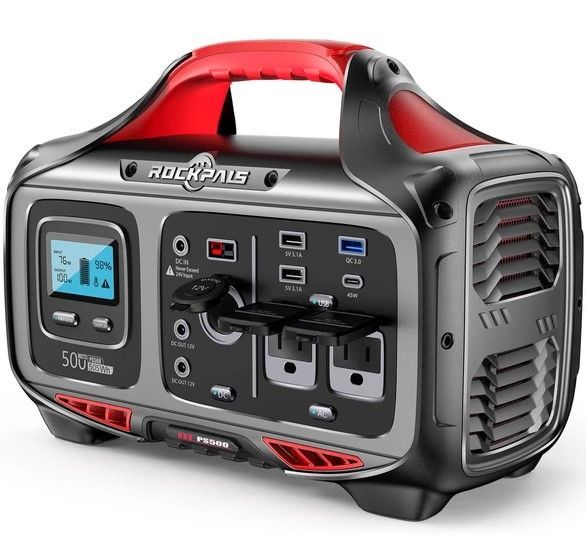
Rockpals Rockpower 500W
- Power: 504 Wh
- Weight: 12.3 lbs.
- Dimensions: 12.0″ x 9.0″ x 6.1″
- Ratings: 4.6⭐ out of 115 reviews on Amazon
- Similarities: Both these portable power stations output about 500 watts of power. They also have 1, 12V DC output, a backlit LCD display and side vents for heat dissipation. Plus, both use MPPT charge controllers and support pass-through charging.
- Where the Explorer 500 fares better: Although both these units have the same inverter rating, the Explorer 500 has a higher surge wattage. Unlike the Rockpals, it has a regulated cigarette port, which keeps the output voltage the same regardless of the remaining battery capacity.
- Where the Rockpals Rockpower 200 fares better: This portable power station offers one extra AC port (2 vs. 1) and has a USB-A QC 3.0 port and USB-C PD port. On top of that, it’s much lighter and more compact than the Explorer 500.
Jackery Explorer 500 Vs EcoFlow River 288

EcoFlow River 288
- Power: 288Wh – 576Wh (With MAX extra battery)
- Weight: 11 lbs.
- Dimensions: 11.3″ x 7.3″ x 7.7″
- Ratings: 4.4⭐ out of 63 reviews on Amazon
- Similarities: Both the Explorer 500 and EcoFlow River 288 can be charged with a compatible solar panel. Their solar panels offer similar maximum conversion efficiencies, too – 23% in the case of SolarSaga 100W and 22% with EcoFlow River 288.
- Where the Explorer 500 fares better: Without an extra battery, the Eco Flow River 288 offers a battery capacity of 288Wh, much lower than the Explorer 500’s. This makes the Explorer 500 much more powerful.
- Where the EcoFlow River 288 better: The EcoFlow River offers higher regular (600W vs. 500W) and surge (1,200W vs. 1,000W) wattages. It also comes with more AC ports (3 vs.1). And you also get 1x USB-C and 1x USB fast-charging port with this model.
Frequently Asked Questions
Can you use Jackery Explorer 500 with non-Jackery solar panels?
Yes. You can use non-Jackery solar panels to recharge the Explorer 500. Just make sure that the solar panel you’ve or intend to buy comes with the 8mm connector. Otherwise, you may have to buy an adapter.
How long does Jackery 500 last?
According to Jackery, the Explorer 500 provides a runtime of 39 hours for a small car fridge or seven hours for a 32-inch TV. Its battery, meanwhile, can retain 80% of its charging capacity for the first 500 charging cycles.
Should I leave my Jackery plugged in all the time?
While there’s no danger in leaving your Jackery plugged in all the time – its built-in safety features protect this model from over-charging, over-voltage and overheating. I suggest you stop charging this portable power station when the battery is full. This may help prolong its shelf life.
How many times can a Jackery be recharged?
The Jackery Explorer 500 can be recharged up to 500 times with its battery retaining up to 80% capacity during that period.
Can a Jackery run a heater?
The Jackery 1500 can run a portable heater. This portable power station features a 1,800W AC inverter that helps it juice up power-intensive devices such as microwave ovens, air conditioners as well as power tools and small-size, portable heaters.
Can you overcharge a Jackery?
All Jackery power stations come with a Battery Management System (BMS). Among other things, the BMS protects the power stations from overcharging.
Can Jackery 500 power a refrigerator?
The Jackery Explorer 500 cannot power a household refrigerator. However, it can power the smallest size (12V) refrigerators used in vehicles.
Can Jackery 500 power a microwave?
The Jackery Explorer 500 cannot power a microwave. That’s because even the standard-size microwaves consume up to 500 watts while running. That is unmanageable for this power station.
Can you use Jackery 500 while recharging?
You can use Jackery 500 while recharging because it supports pass-through charging.
How many times can Jackery 500 charge an electric cooler?
The Jackery 500 can keep a 60 mini-electric cooler running for 9 hours on a full charge. Keep in mind that this time is based on the assumption that you won’t be charging any other devices during the time you’ll have your electric cooler hooked to the Jackery 500.
Final Verdict: Should You Buy Jackery Explorer 500?
If you’re looking for a portable power station that could charge everyday gadgets such as laptops, smartphones, tablets, as well as sensitive electronics, the Jackery Explorer 500 is worth a shot. With its super-efficient Li-ion battery, support for pass-through charging, and a built-in MPPT controller, this portable power station won’t make you regret its choice.
Check out the video review
Jackery Explorer Comparison Table
This table compares the main differences between Jackery Explorer Portable Power Stations
| Jackery Model | Capacity | Weight, lbs | Dimensions, in | AC Recharge time | Solar Recharge Time | Compatible Solar Panel |
|---|---|---|---|---|---|---|
| Explorer 160 | 167Wh | 3.97 | 7.4 x 4.5 x 6.7 | 5 Hours | 4.5 Hours | SolarSaga 60W |
| Explorer 240 | 240Wh | 6.6 | 9.05 x 5.24 x 7.87 | 5.5 Hours | 7 Hours | SolarSaga 60W |
| Explorer 300 | 293Wh | 7.1 | 9.1 x 5.2 x 7.8 | 4.5 Hours | 5 Hours | SolarSaga 100W |
| Explorer 500 | 518Wh | 13.32 | 11.8 x 7.6 x 9.2 | 7.5 Hours | 9.5 Hours | SolarSaga 100W |
| Explorer 1000 | 1002Wh | 22.04 | 13.1 x 9.2 x 11.1 | 7 Hours | 8 Hours | SolarSaga 100W |
| Explorer 1000 Pro | 1002Wh | 25.35 | 13.39 x 10.32 x 10.06 | 1.8 Hours | 1.8 Hours | SolarSaga 200W |
| Explorer 1500 Pro | 1512Wh | 37.4 | 15.1 x 10.6 x 12.1 | 2 Hours | 4 Hours | SolarSaga 100W |
| Explorer 2000 Pro | 2160Wh | 43 | 15.1 x 10.5 x 12.1 | 2 Hours | 4 Hours | SolarSaga 200W |
| Explorer 3000 Pro | 3024Wh | 63.93 | 18.6 x 14.1 x 14.7 | 2.4 Hours | 3-4 Hours | SolarSaga 200W |
Portable power station guides
Use this table to find out all the reviews I made about the best portable power stations in the industry.

